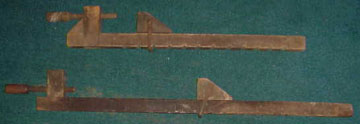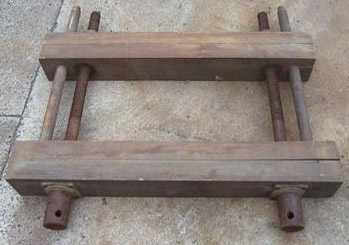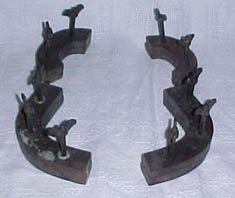 (examples: presses for grapes, apples, cheese,
linen, etc.)
(examples: presses for grapes, apples, cheese,
linen, etc.)In this, and most, examples, there are guides in the frame to ensure the block stays in place. In other examples, the block is round, and it doesn't matter.
Top of Site > Clamps as Things > Field Guide > Taxonomy
Table of Contents
This is an attempt to classify devices using screws in order to exert pressure on a work piece, to put it either in compression, or in tension. (Screws used mostly for positioning or fastening are excluded; the existence of borderline cases is acknowledged.) There are other clamping systems based on wedges, on the elastic properties of stretched fiber or rubber, on the temporary deformation of cams or bars or other solid pieces. 'Nother topic, 'nother place, not here.
The screw directly exerts a force, possibly through a pad to distribute the force.
Note that in these devices, the screw is in compression.
(example: house jack)
 (examples: presses for grapes, apples, cheese,
linen, etc.)
(examples: presses for grapes, apples, cheese,
linen, etc.)
In this, and most, examples, there are guides in the frame to ensure
the block stays in place. In other examples, the block is round, and
it doesn't matter.
In some cases, the framwork is minimal. An example is the window or panel clamp. At one end is a cross-piece (1 to 2 inches thick, 3 to 6 inches deep, and 10 to 12 inches wide) attached firmly to the end of two guide bars, about 10 inches apart, and tapped for a threaded shaft that presses on a second piece ("jaw") of about the same size. The "jaw" has holes for the guide bars. The usual range of adjustment is about 6 inches. At the other end is an adjustable cross-piece (about the same size as the other two) pierced for the two guide bars, and held in place by pegs in holes in the guide bars, acting as stops. A common length for the guide bars is some 4 to 5 feet, adequate for most window sashes and panels. The depth of the cross-pieces is usually enough to allow two items to be clamped at the same time, one on each side of the guide bars.
 (examples: C-clamps, bar clamps)
(examples: C-clamps, bar clamps)
The screw exerts a force on an intermediary jaw or block, which exerts the working force
Note that in these devices, the screw is usually in tension.
(example: typical machinist vise)
(examples: typical leg vise, some stretchers)
The screws are in tension.
 (example: bookbinder's vise)
(example: bookbinder's vise)
This photo shows the use of guide rods to ensure that the jaws
remain parallel.
this is our beloved hand screw!
Note that the end screw is in compression, while the middle screw is in tension.
(example: stretchers; see also the exotic church boat clamp. )
(example: carver vise)
(example: Jorgensen style clamp)
(examples ?)
 (example: luthier's clamps)
(example: luthier's clamps)
This photo shows the use of curved jaws to fit the shape of the
instrument.
alternate luthier's clamps?
last revised and validated
Copyright © 1996- Wooden Clamp Journal